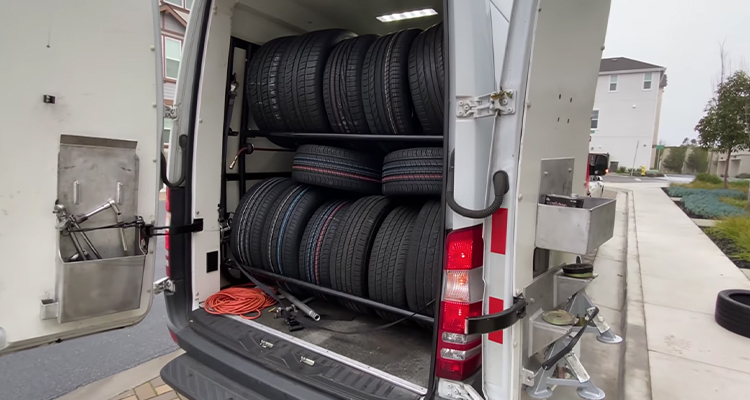Premium Mobile Tire Replacement Las Vegas - High Quality Assured
Premium Mobile Tire Replacement Las Vegas - High Quality Assured
Blog Article
Tire Service: Proven Approaches for Optimal Tire Upkeep and Treatment
Maintaining optimum tire condition is extremely important for both safety and security and performance of any vehicle. From ensuring correct tire pressure to normal turning and positioning, there are proven methods that can dramatically extend the lifespan of your tires and improve overall driving experience. As we discover the intricacies of tire care and maintenance, we will reveal important standards that every automobile owner should follow for the very best possible outcomes. Allow's delve into the globe of tire solution and uncover the keys to keeping your tires in top-notch form for the lengthy haul.
Value of Tire Pressure
Sufficient tire stress promotes far better gas efficiency, as under-inflated tires can lead to boosted rolling resistance, causing the engine to work more challenging and take in even more fuel. Right tire stress makes certain even walk wear, enhancing tire durability and saving cash in the long run by delaying the demand for early substitutes. Regularly checking and changing tire stress, especially in the past lengthy trips, is a straightforward yet efficient means to improve car efficiency, prolong tire life expectancy, and prioritize safety on the roadway.
Tire Rotation Guidelines
When considering tire rotation guidelines, it is necessary to recognize the relevance of this upkeep task in optimizing tire life expectancy and keeping ideal vehicle performance. Tire turning involves altering the setting of each tire on a car to ensure also tread wear. Front tires have a tendency to put on a lot more rapidly than back tires because of guiding forces, making normal turning important for balanced wear patterns. The suggested turning pattern differs depending on whether an automobile is front-wheel, rear-wheel, all-wheel, or four-wheel drive. Typically, tires must be turned every 5,000 to 7,500 miles, or as recommended in the car manual. Ignoring tire rotation can cause uneven wear, influencing handling, traction, and potentially compromising lorry safety. By sticking to correct rotation standards, drivers can expand the life of their tires, enhance fuel efficiency, and improve total driving experience. Normal rotation is a basic yet reliable upkeep technique that adds substantially to tire longevity and lorry performance.

Benefits of Wheel Placement
Making sure appropriate wheel alignment after tire turning is essential for preserving well balanced wear patterns and making best use of lorry efficiency. Wheel alignment refers to the adjustment of the angles of the wheels to the producer's specifications. One of the key advantages of wheel alignment is enhanced handling and steering feedback. When the wheels are appropriately lined up, it minimizes guiding effort, making sure a smoother and more regulated driving experience. In addition, appropriate wheel placement aids to extend the lifespan of your tires. Misaligned wheels can trigger unequal tire wear, causing early tire replacement and increased maintenance costs.

Tire Tread Deepness Inspect
Executing a normal examination of tire walk deepness is vital for maintaining secure driving conditions and extending the life-span of your tires. The walk on your tires plays a vital duty in giving traction, specifically in wet or unsafe problems. my link To check your tire tread depth, you can utilize a step depth scale or the penny examination. The suggested step deepness is at least 2/32 of an inch. It is time to replace your tires to guarantee ideal efficiency and safety and security on the road if the tread deepness is listed below this threshold. Irregular tread wear can show problems with tire suspension, alignment, or stress, highlighting the relevance of routine walk deepness checks. Overlooking to keep track of more helpful hints and preserve proper tread depth can cause reduced grip, longer braking distances, and a raised risk of hydroplaning. By including tire walk depth look into your regular upkeep schedule, you can drive with confidence knowing that your tires are in leading condition.
Seasonal Tire Examination
Seasonal tire inspection is an essential aspect of tire upkeep that ensures tires are ready to face the difficulties presented by various climate conditions. In preparation for winter, it is crucial to inspect the tire stress on a regular basis as cool temperatures can cause tire pressure to drop. By carrying out routine seasonal tire examinations, drivers can lengthen tire lifespan, boost gas effectiveness, and most significantly, make certain a protected driving experience in varying weather problems.
Conclusion
In conclusion, maintaining correct tire stress, rotating tires on a regular basis, straightening wheels properly, monitoring step deepness, and carrying out seasonal inspections are vital practices for optimum tire treatment. By following these proven techniques, vehicle drivers can guarantee their tires last much longer, execute better, and contribute the original source to general vehicle safety and security. It is necessary to focus on tire maintenance to stop crashes, improve fuel performance, and extend the life expectancy of tires.
Adequate tire pressure promotes much better gas performance, as under-inflated tires can lead to enhanced rolling resistance, triggering the engine to function more difficult and consume more fuel.When taking into consideration tire turning standards, it is essential to understand the value of this upkeep job in making the most of tire lifespan and preserving optimum car performance. Seasonal tire assessment is a fundamental aspect of tire upkeep that ensures tires are all set to face the difficulties presented by various climate problems. By performing routine seasonal tire assessments, motorists can prolong tire life expectancy, enhance fuel efficiency, and most notably, make certain a safe and secure driving experience in differing weather condition problems.
In conclusion, preserving appropriate tire pressure, rotating tires on a regular basis, lining up wheels properly, keeping an eye on walk depth, and carrying out seasonal inspections are important practices for ideal tire treatment.
Report this page